
views
X
Trustworthy Source
Mayo Clinic
Educational website from one of the world's leading hospitals
Go to source
The results of regular aerobic exercise are lower blood pressure and cholesterol, improved lung function, a lower resting heart rate and improved cardiovascular health, weight loss, and muscle definition. While this can be achieved through jogging or playing basketball, when we talk about “aerobics,” we're talking about a specific type of exercise that often incorporates music and dancercise to make aerobic exercise fun, keeping you coming back for more.
Preparing for an Aerobics Workout

Determine what sort of aerobics you want. Some people are happy putting together their own workout, but more often this involves finding a program that appeals to you. Aerobic classes tend to have a lot of factors to consider when joining one. Some major ones: Gym or home? Do you prefer going to a gym, or doing workouts at home with a DVD? The type of aerobic genre. There are many types of workouts, including: Targeted audiences: Aerobics for senior citizens, men, pregnant women, etc. Themes: boot camp, martial arts, hip hop, etc. Instructor. Classes tend to focus around the directions of the leader, (whether in real life or virtual) and if it is not a good match for you, it can ruin the experience. Different aerobics instructors will have different personalities, sensibilities, and demeanors. High versus low-impact. A more lengthy explanation of the pros and cons are below. Your current fitness level. If you are in great shape, maybe a very energetic program is for you. But if you are just starting out, you will need a more beginner program.
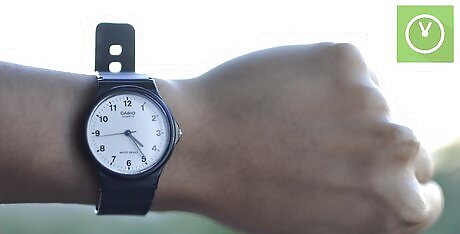
Set aside enough time to meet exercise recommendations. Regardless of your goals — losing weight or just improving overall health — you won't see or feel any change in your body unless you exercise regularly. The U.S. Department of Health and Human Services recommends that adults get at least 2.5 hours of moderate aerobic exercise (low-impact aerobics) or 75 minutes of strenuous aerobic exercise (high-impact aerobics) per week. So one hour-long low-impact aerobics class per week isn't enough to meet professional standards for a healthy lifestyle. Set aside enough time throughout the week to reach your exercise goals. Another way to approach your routine is to elevate your heart rate for half an hour every day, taking a day off here and there. If you are trying to lose weight, you should increase the amount of time you dedicate to exercise, as these recommendations are a minimum guideline for healthy living.

Pre-prepare a workout plan. Regardless of what type of aerobics you're doing, you want to make sure you're working out your entire body in a thoughtful manner. Of the five recommended elements of physical activity — aerobic exercise, strength training, core exercise, balance training, and flexibility — aerobics itself is simply one piece of the overall picture. However, with a little bit of pre-planning, you can incorporate steps and tools into your workout plan that help you achieve the recommended balance. Aerobic exercise: obviously, you want to keep your heart rate elevated throughout. This is why aerobics instructors ask you to march in place in between steps rather than stopping and taking a break. If you can speak easily, you're not working out hard enough. Strength training: Holding hand weights while performing your aerobics routine will help build muscles in the arm, while adding ankle weights will build leg muscle. Core strength: Incorporate moves that target the muscles in your abdomen — windmills, for example. The addition of hand weights while performing windmills will result in an even better core workout. Balance training: Many moves in aerobics require you to shift your weight from one foot to the other. Focus on the slow, deliberate transfer of weight and the balance of your body when doing these steps. Hamstring curls and ski jumps, for example, are a good opportunity to focus on balance. Flexibility: When performing steps that require stretching, commit all the way to the stretch. Windmills are a great example of an exercise where you may not be able to reach your feet at first due to poor flexibility. With some attention and practice, your flexibility will increase over time.
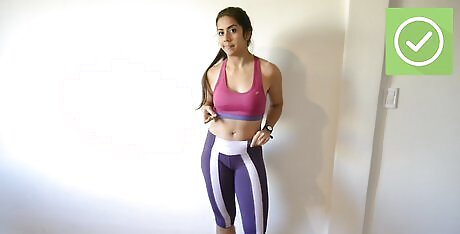
Wear clothes that let you move. Aerobics will lead you through a wide range of motion, so don't wear stiff clothes that will keep you from moving your arms and legs comfortably. You'll also sweat a lot, so wear clothes that won't make you overheat — athletic shorts and a t-shirt will work just fine. Make sure you're wearing shoes designed for exercise, not flats or work shoes.
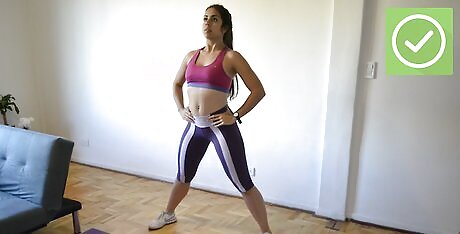
Prepare a large, clear area. You'll be swinging your arms, kicking your legs, and moving around while doing your aerobics routine. You don't want to knock things over, so pull tables and chairs into a corner, clearing a large space where you can move freely without having to worry about breaking something or hurting yourself by running into a table.

Make a good workout playlist. Studies have shown a correlation between a good workout playlist and increased workout efficiency. Because the main point of aerobics is to raise your heart rate, choose only music that has a fast rhythm, so you'll have to work hard to keep up with the beat. Only choose songs that you like, though! The more you enjoy the music, the more you'll get into the steps you're doing, and the better your workout will be. Furthermore, if you enjoy the workout because of the music, you'll be less likely to get bored and stop working out after a couple of sessions. EXPERT TIP Laila Ajani Laila Ajani Fitness Trainer Laila Ajani is a Fitness Trainer and founder of Push Personal Fitness, a personal training organization based in the San Francisco Bay Area. With over 10 years as a trainer and exercise specialist, Laila has expertise in competitive athletics (gymnastics, powerlifting, and tennis), personal training, distance running, and Olympic lifting. Laila is certified by the National Strength & Conditioning Association (NSCA), USA Powerlifting (USAPL), and she is a Corrective Exercise Specialist (CES). Laila Ajani Laila Ajani Fitness Trainer Cardio can be fun. Find stimulating ways to make your treadmill workouts more engaging. Create a playlist of your favorite workout songs, watch a show or fitness class while you're on the machine, or try a dance routine from YouTube. To mix things up, switch between cardio machines like the treadmill, bike, rowing machine, and elliptical. Remember, you don't have to stick to traditional cardio exercises. You can also try fun activities like salsa dancing or playing a sport you enjoyed as a child.
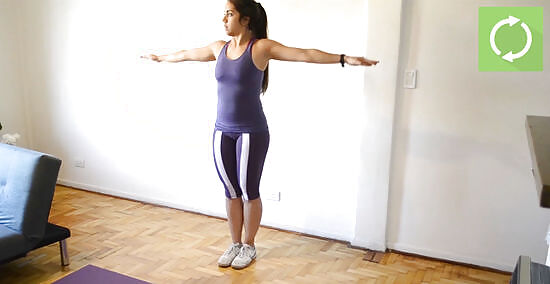
Do dynamic stretches before exercising. Dynamic stretches are movements that go through a full range of motion as opposed to static stretches that are held for twenty or thirty seconds. There are many different types of dynamic stretches that you can do to warm up. Arm circles can help increase the range of motion in your shoulders. Hold your arms out straight to form a T. Make small circles with them for ten seconds before reversing the direction of the circle. Raise your arms in front of you before bringing them straight above your head. Try to bring them down as far back behind you as they will go. Move them back to starting position, and repeat. Lie down to do hip and knee bends. Bend your knee as you bring it up towards your chest. Slowly straighten it back out again. Repeat with the other leg.
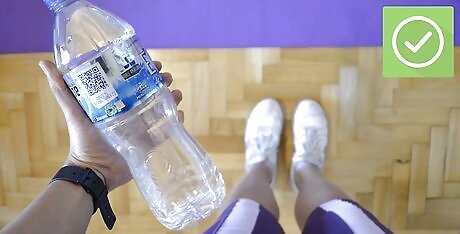
Keep a water bottle handy. As you're sweating during your workout, your body will begin to dehydrate. If you don't replenish your body with water throughout your workout, you can overexert and hurt yourself, so keep water nearby and drink whenever you get thirsty or need to cool down a little.
Doing Low-Impact Aerobics

Understand reasons for choosing low-impact aerobics. Low-impact aerobics avoid movements that put a lot of pressure on joints, including movements like jumping, running in place, and the like. Low-impact aerobics is designed to minimize the risk of leg injuries, and is recommended for seniors, pregnant women, and overweight people. If you fall into one of those categories or have joint problems you should not attempt high-impact aerobics at all, unless you doctor approves it for you. If you're out of shape and want to ease your way into a workout regimen, low-impact aerobics is a great way to get your body used to a range of motions before you start pushing yourself. Low-impact aerobics are not only for people with "issues". Many workouts designed for minimizing impact are just as effective as high impact, without as much risk of injury. Not all "low-impact aerobics" are appropriate for everyone. It is not risk-free. A very overweight or out of shape person may still get injured if he or she is working out at too high a level. Using improper form or incorrect movement patterns may also cause injury. Cycle through a variety of different motions. It doesn't matter what order you go in, but stay in each motion for at least one or two minutes before moving on to the next motion. You should repeat the same motions repeatedly throughout your workout. If you are having difficulty with a more advanced move, return to more basic movements, such as stepping back and forth. Once your muscles stop burning, go back to the more difficult motions.

March in place to warm up. Don't begin your workout in earnest until you've warmed up your body. In warming up, you gradually increase blood flow throughout your body and loosen up the muscle groups you'll be using, reducing the risk of muscle stress. Use the rhythm of the music you're playing to guide your steps, but the music should be fairly fast-paced to make sure you're moving fast enough to get your heart rate up. Your arms can hang naturally at your sides, or you can swing them in a sharp, but controlled motion to work out your arm muscles as well. Make sure to lift your knees enough to cause your legs to burn over a period of time. Simply shuffling in place will not make you sweat! Do this for at least two minutes to warm your body up in preparation for a wider range of more demanding movements. Get into the music! Clap your hands if you feel like it. The more fun you're having, the more likely you'll be to continue exercising.
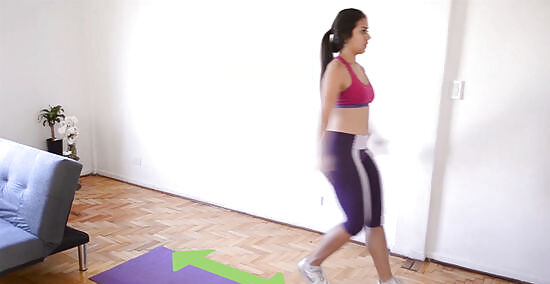
Travel forwards and backwards. Walk forward three steps, swinging your arms energetically at your sides; on the fourth count, tap your foot on the ground and clap your hands. Repeat this motion moving backwards, so you end up where you began. Remember to change which leg you being with. Repeat motion for as long as you'd like, until you get bored of it and want to move on to a new movement.
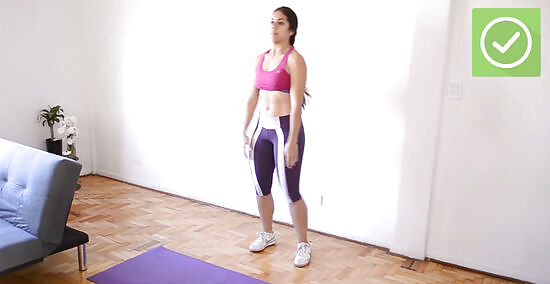
Perform heel digs. Staying in place, extend each leg forward and tap the heel of the foot against the ground, alternating legs to the beat of the music. Lift your hands to shoulder or chest level every time you draw a foot back, and fully extend your arms downward with every foot extension. Keep your motions controlled and deliberate to make sure that you're engaging your muscles instead of letting gravity do all the work for you.

Do step-touches. Take a wide, but comfortable step to the right (don't lose your balance!), then bring your left foot to your right foot and touch the ground with it. Move your left foot back out to your original position, then touch your right foot to the ground by your left foot. You can combine this with any number of arm movements, from controlled arm swings to shoulder rolls. A shoulder roll is simply when you pull one shoulder forward slightly, then roll it up and back. Alternate shoulders to the beat of the music, working out your shoulder and back muscles.

Do duck walks. Stand with your feet shoulder-width apart. Lower your body into a squat, and start taking small steps forward. Continue walking forward for thirty to sixty seconds. This increases the burn in your thighs. You can pump your arms in a controlled manner at your sides. It's important to keep a straight back during this step to prevent back pain.

Do grapevines. Take a comfortably wide step to the left, but when you bring your right foot over to meet it, cross your right foot behind and past your left foot; with your weight on your right foot, bring your left foot over to the left to stand comfortably for a beat before bringing your right in to tap your left foot. Then repeat the process to the right side. Kick your leg out to the front on the last beat (when you would normally simply tap one foot to the other) to increase your activity rate. Begin the movement to the left with your arms down, and slowly lift them out to your sides and up over your head in a deliberate, wide motion, with your hands meeting over your head on the fourth beat. Bring your arms down during your movement to the right so the return to their beginning position.
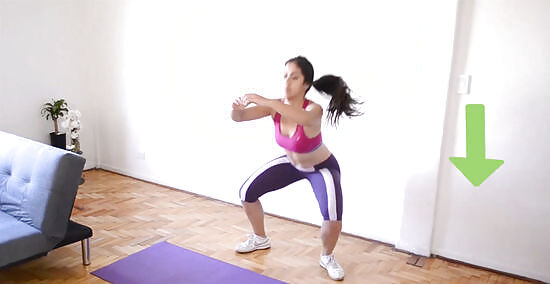
Perform hamstring curls. Take a comfortably wide step to the right, then lift your left heel behind you, bending at the knee. Don't swing your entire leg, just bend your heel back toward your bottom. Bring your foot back down, then repeat the motion on the left side, alternating sides to the rhythm of the music. You can push your arms forward as though pushing the air away from your chest on the leg curl, then pull your arms back into your chest when you return your foot to the ground. You can also do bow-and-arrows with your arms: extend one arm out directly to the side and tuck the other into your chest while keeping your elbow pointed out to the side. Alternate sides to match your feet movement. The motion should look a little bit like using a bow and arrow. To increase the muscle exertion, you can double or triple up on the curls you do on each side before moving on to the other leg. This way, you muscle doesn't get to relax immediately, and the workout is a little more difficult.
Purchase a low-impact aerobics DVD. It is inexpensive, but it also counts as active screen time.
Doing High-Impact Aerobics

Do high-impact aerobics if you have healthy joints and are in shape enough. Research suggests that when healthy bodies engage in activities that exert force on the joints, it can actually help build and strengthen bone, and of course, more strenuous exercise raises the heart rate more. Again, do not attempt high impact aerobics if you have joint or bone pain, unless your doctor permits it. If you think you're in good enough shape to jump right into high impact aerobics, this is a great way to get your heart rate pumping harder and shape your muscles more than low impact aerobics. Just as with low impact aerobics, you will create your own combinations and routines from a range of steps, all performed to high-paced music.

Warm up. Warm up just as you would for low-impact aerobics, by marching in place. This is just to get your body ready for physical exertion. Perform dynamic movements with a full range of motion. Start by doing arm, shoulder, leg, ankle and wrist circles. Gradually increase the range of motion by doing knee, neck and back bends. March in place for about two minutes before beginning your combinations.
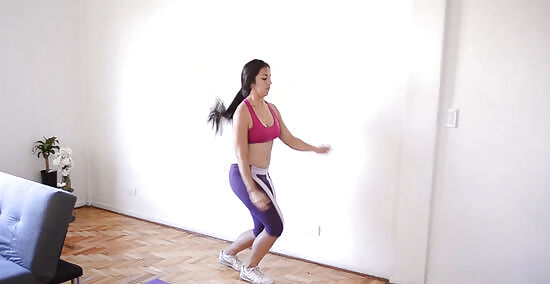
Do scissor steps. This motion calls for you to jump, moving your legs back and forth in a scissoring motion. You can keep your hands on your hips or swing them in a controlled motion at your sides, as you normally would during walking or running, but with a more exaggerated range. From a standing position, jump so your left foot is forward and your right foot is back. Jump again, switching the position of your feet. You should switch foot position for each beat of the song you're listening to. Make sure to center your balance. Put your arms out to the side to stabilize yourself if you feel like you're going to fall.
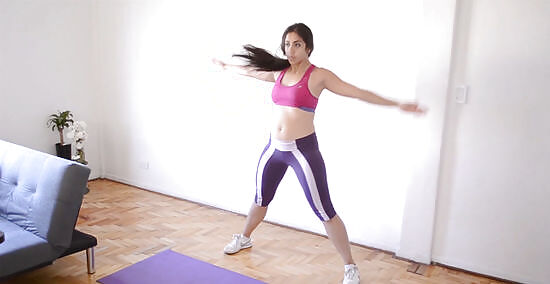
Do windmills. This motion is stationary, in that your feet are set, but it's still a difficult motion and you can lose your balance if you're not careful. Begin with your feet about shoulder-width apart, in the “stride” position. Extend your arms out directly to your sides, making sure they stay parallel to the ground. Keeping your arms straight through the elbow, reach your right arm down to touch the instep of your left shoe. Do you best not to bend your knees. Your left arm should swing behind your body, and your face should rotate to look out to the left. Return to your original position, then repeat on the other side, touching your left hand to your right shoe. Keep your abs contracted. Make sure that your back straight as flat as possible instead of letting it slump and get rounded.

Jog in place. Let your arms swing naturally at your side as they would during a normal jogging motion. If you want to make this motion more difficult, bring your knees up higher. Alternate between normal jogging and high-knee jogging to keep your heart rate up without wearing yourself out completely.

Do ski jumps. Begin in a position like you do when you're skiing, with your knees bent, your torso leaned forward slightly, and your hands at your chest with your elbows tucked in. From your bending position, jump up and to the right side, making sure you jump with both feet at the same time, then land with both feet at the same time. Balance your weight over your heels and sink down into your bent stance again. The jumping movement should be completely lateral, not forward and back. As you're completing the jumping motion with your legs, bring your hands up to the sides of your head as you extend into the jump, then bring them down to your sides, keeping elbows bent, as you land and go back into your bent position. Jump from left to right, repeating this motion. To increase the level of difficulty, place an object next to you to jump over. By increasing the required height of the jump, you'll get a better workout.
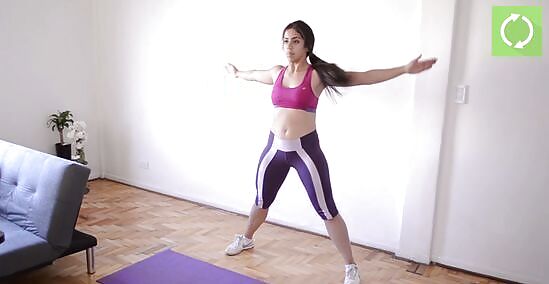
Do repeater movements of basic steps. Regardless of which step you're doing — from hamstring curls to windmills — repeat each motion three times before switching sides. This increases the level of difficulty and makes your muscles burn more quickly, since you don't get a chance to rest that side of your body immediately after performing a movement.
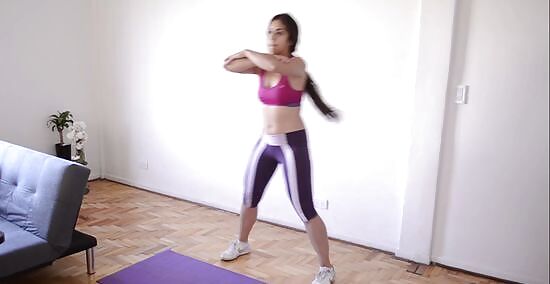
Find a high impact aerobics class. There are many styles of high impact aerobic exercise, so you should be able to find one that meets your liking. Some examples of classes to keep an eye out for include: Step aerobics Zumba, a dance exercise that incorporates Latin and world music Crossfit training, a demanding exercise program that cycles you through a wide variety of exercises and styles Capoeira, a Brazilian martial arts form that incorporates dance and acrobatics set to music Tae Bo, an aerobic exercise form that combines elements of Tae Kwon Do, karate, boxing, and dance. Call your local gyms and inquire into the high impact aerobic classes they offer.



















Comments
0 comment